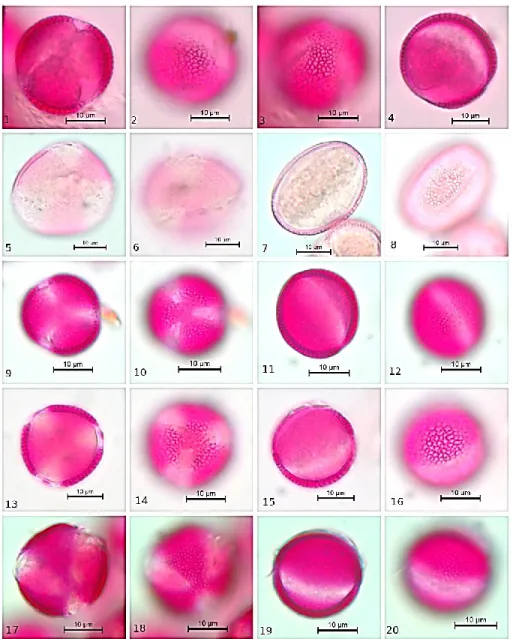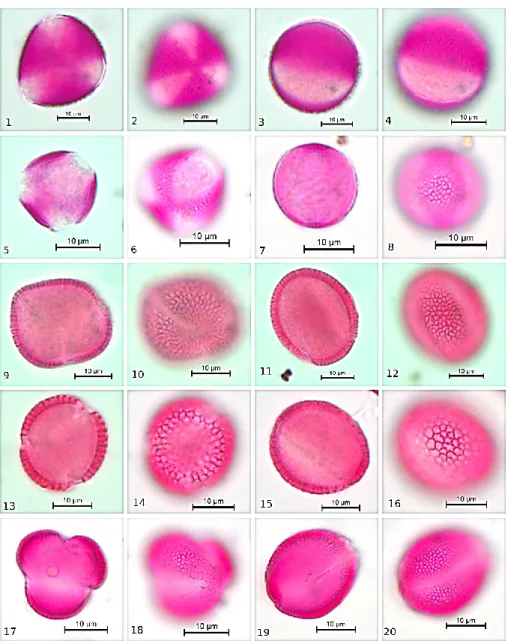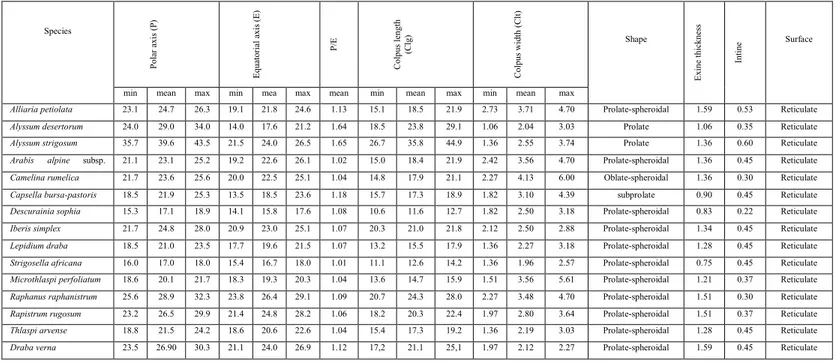DOI: 10.1501/commuc_0000000211 ISSN 1303-6025 E-ISSN 2651-3749
http://communications.science.ankara.edu.tr/index.php?series=C
Received by the editors: November 06, 2018; Accepted: December 02, 2018.
Key word and phrases: Brassicaceae, pollen, light microscopy (LM), Kastamonu University campus, Turkey Submitted via II. Aerobiology and Palynology Symposium 07-10 October 2018 (APAS 2018)
© 2018 Ankara University Communications Faculty of Sciences University of Ankara Series C: Biology POLLEN FLORA OF KASTAMONU UNIVERSITY CAMPUS I:
BRASSICACEAE
MOHAMED NURI ELTAJOURI, TALIP CETER, BARIS BANI
Abstract. Plants used in this study were collected from Kastamonu University campus and its surrounding in Turkey. Samples prepared according to Wodehouse (1935) technique, and they were examined by light microscopy to study the characteristic of pollen grains. Pollen grains of studied taxa observed as isopolar, radially symmetric with tricolpate aperture and prolate-spheroidal, subprolate and prolate pollen shape. Polar axis range between 15.30-43.53 µm while equatorial axis between 13.48-29.09 µm. Alyssum strigosum pollen measured as biggest pollen while Strigosella africana pollen is the smallest. Pollen surface ornamentation determined as reticulate. Exine thickness and intine thickness were varied between 0.4-2.3 µm, 0.1-0.9 µm, respectively. The characters like as polar axis, equatorial axis, pollen shape, pollen surface ornamentation, intine and exine thickness determined as important features for systematics of taxa.
1. Introduction
Brassicaceae is a cosmopolitan family, occurring mainly in north temperate zone particularly in Mediterranean region. The family Brassicaceae is distributed worldwide across all continents except for Antarctica. It consists of 51 tribes, about 338 genera, and 3709 species. The Brassicaceae is easily distinguished from other flowering plant families with floral and fruit morphology by the cruciform corolla, tetradynamous stamens, and a siliqua often with a septum.
Turkey is one of the richest countries in the world in terms of the number of species of the Brassicaceae. The family present 571 species, 65 subspecies, 24 varieties and 660 taxa belonging to 91 genera is approximately [1-5].
Studying various biological aspects of pollen grains has contributed to the development of multiple scientific fields. The shape of pollen grains varies both among the genera but vary rarely among the species within the same genus. Pollen morphology has provided an approach to the systematic relationships among the genera of the Brassicaceae. Pollen grains of Brassicaceae usually radially symmetrical, isopolar, sub-prolate or prolate to prolate-spheroidal, rarely
oblate-spheroidal, tricolpate often 4-8 colpate. Sexine thinner or thicker than nexine. Tectum fine to coarse reticulate or reticulate-rugulate [6-9].
Many researchers have emphasized the importance of pollen morphology for the Brassicaceae family [10]. Pollen morphology of some taxa belong to Brassicaceae i.e.; Asyneuma canescens [11], Hesperis [12], Isatis [13], Rorippa [14], Barbarea [15], Arabis [16], Aethionema [17-19], Malcolmia [20], Crambe [21] and Noccaeae
aghrica [22] distributed in Turkey were studied in detail.
The objective of this study was to examine the pollen morphology 15 species belong to Brassicaceae and to determine the contributions of pollen morphology to taxonomy of the family.
2. Material And Method 2.1. Plant specimens
Plants used in this study were collected from Kastamonu University campus and its surrounding in Turkey.
Plants species
Alliaria petiolata (M.Bieb.) Cavara & Grande Alyssum desertorum StapfAlyssum strigosum Banks & Sol. Arabis alpina L. subsp. alpina Camelina rumelica Velen.
Capsella bursa-pastoris (L.) Medik. Descurainia sophia (L.) Webb ex Prantl. Draba verna L.
Iberis simplex DC. Lepidium draba L.
Strigosella africana (L.) Botsch. Microthlaspi perfoliatum (L.) F.K.Mey Raphanus raphanistrum L.
Rapistrum rugosum (L.) All. Thlaspi arvense L.
2.2. Pollen analysis
Pollen samples prepared according to Wodehouse [23] method and they were examined by light microscopy. For each pollen characteristic measurement taken from 20 different pollen grain [24].
Terminology was adopted from Faegri and Iversen [25], Punt et al. [26], Hesse et al. [27], Pınar et al. [12], and shape classification follows that of Erdtman [28] based on P/E ratio in Table 1.
3. Results And Discussion 3.1. Alliaria petiolata
Pollen shape is prolate-spheroidal with 23.07-26.30 µm polar axis and 19.07-24.61 µm equatorial axis. Exine thickness is between 0.92-2.27 µm. Intine thickness is between 0.30-0.76 µm. Colpus is long with acute ends and clear margins (Clg 15.15-21.96 µm, Clt 2.73-4.70 µm). Ornamentation is reticulate. (Figure 1 (1-4), Table 1). 3.2. Alyssum desertorum
Pollen shape is prolate with the 24.09-34.09 µm polar axis and 14.09-21.21 µm equatorial axis. Exine thickness is between 0.76-1.36 µm. Intine thickness is between 0.30-0.76 µm. Colpus is long with acute ends and clear margins (Clg 18.48-29.09 µm, Clt 1.06-3.03 µm). Ornamentation is reticulate. (Figure 1 (5-8), Table 1). 3.3. Alyssum strigosum
Pollen shape is prolate with 35.75-43.53 µm polar axis and 21.53-26.51 µm equatorial axis. Exine thickness is between 0.91-1.82 µm. Intine thickness is between 0.30-0.91 µm. Colpus is long with acute ends and clear margins (Clg 26.66-44.90 µm, Clt 1.36-3.74 µm). Ornamentation is reticulate. (Figure 1 (9-12), Table 1).
3.4. Arabis alpine subsp. Alpine
Pollen shape is prolate-spheroidal with 21.06-25.23 µm polar axis and 19.24-26.06 µm equatorial axis. Exine thickness is between 0.91-1.82 µm. Intine thickness is
between 0.30-0.61 µm. Colpus is long with acute ends and clear margins (Clg 15.00-21.96 µm, Clt 2.42-4.70 µm). Ornamentation is reticulate. (Figure 1(13-16), Table 1).
3.5. Camelina rumelica
Pollen shape is oblate-spheroidal with 21.66-25.60 µm polar axis and 20.00-25.15 µm equatorial axis. Exine thickness is between 1.06-1.67 µm. Intine thickness is between 0.15-0.45 µm. Colpus is long with acute ends and clear margins (Clg 14.84-21.06 µm, Clt 2.27-6.00 µm). Ornamentation is reticulate. (Figure 1 (17-20), Table 1).
3.6. Capsella bursa-pastoris
Pollen shape is subprolate with 18.48-25.30 µm polar axis and 13.48-23.63 µm equatorial axis. Exine thickness is between 0.76-1.06 µm. Intine thickness is between 0.15-0.76 µm. Colpus is long with acute ends and clear margins (Clg 15.75-18.93 µm, Clt 1.82-4.39 µm). Ornamentation is reticulate. (Figure 2 (1-4), Table 1). 3.7. Descurainia Sophia
Pollen shape is prolate-spheroidal with 15.30-18.88 µm polar axis and 14.09-17.57 µm equatorial axis. Exine thickness is between 0.45-1.21 µm. Intine thickness is between 0.15-0.30 µm. Colpus is long with acute ends and clear margins (Clg 10.60-12.72 µm, Clt 1.82-3.18 µm). Ornamentation is always reticulate. (Figure 2 (5-8), Table 1).
3.8. Iberis simplex
Pollen shape is prolate-spheroidal with 21.66-28.03 µm polar axis and 20.90-25.15 µm equatorial axis. Exine thickness is between 1.21-1.67 µm. Intine thickness is between 0.30-0.61 µm. Colpus is long with acute ends and clear margins (Clg 20.30-21.80 µm, Clt 2.12-2.88 µm). Ornamentation is always reticulate. (Figure 2 (13-16), Table 1).
3.9. Lepidium draba
Pollen shape is prolate-spheroidal with 18.48-23.48 µm polar axis and 17.72-21.51 µm equatorial axis. Exine thickness is between 0.91-1.67 µm. Intine thickness is
between 0.15-0.76 µm. Colpus is long with acute ends and clear margins (Clg 13.18-17.87 µm, Clt 1.36-3.18 µm). Ornamentation is reticulate. (Figure 2 (17-20), Table 1).
3.10. Strigosella Africana
Pollen shape is prolate-spheroidal with 16.06-18.03 µm polar axis and 15.45-18.08 µm equatorial axis. Exine thickness is between 0.45-1.06 µm. Intine thickness is between 0.15-0.76 µm. Colpus is long with acute ends and clear margins (Clg 11.06-14.24 µm, Clt 1.36-2.57 µm). Ornamentation is reticulate. (Figure 3 (1-4), Table 1). 3.11. Microthlaspi perfoliatum
Pollen shape is prolate-spheroidal with the 18.63-21.66 µm polar axis and 18.33-20.30 µm equatorial axis. Exine thickness is between 0.76-1.67 µm. Intine thickness is between 0.15-0.61 µm. Colpus is long with acute ends and clear margins (Clg 13.63-15.90 µm, Clt 1.51-5.61 µm). Ornamentation is reticulate. (Figure 3 (5-8), Table 1).
3.12. Raphanus raphanistrum
Pollen shape is prolate-spheroidal with the 25.60-32.27 µm polar axis and 23.78-29.09 µm equatorial axis. Exine thickness is between 1.21-1.82 µm. Intine thickness is between 0.15-0.45 µm. Colpus is long with acute ends and clear margins (Clg 20.75-28.03 µm, Clt 2.27-4.70 µm). Ornamentation is reticulate. (Figure 3 (9-12), Table 1).
3.13. Rapistrum rugosum
Pollen shape is prolate-spheroidal with 23.18-29.84 µm polar axis and 21.36-28.18 µm equatorial axis. Exine thickness is between 1.06-1.97 µm. Intine thickness is between 0.15-0.61 µm. Colpus is long with acute ends and clear margins (Clg 18.18-22.42 µm, Clt 1.97-3.64 µm).Ornamentation is reticulate. (Figure 3 (13-16), Table 1).
3.14. Thlaspi arvense
Pollen shape is prolate-spheroidal with 18.78-24.24 µm polar axis and 18.63-22.57 µm equatorial axis. Exine thickness is between 0.91-1.67 µm. Intine thickness is between 0.15-0.76 µm. Colpus is long with acute ends and clear margins (Clg 15.45-19.24 µm, Clt 1.36-3.03 µm). Ornamentation is reticulate. (Figure 3 (17-20), Table 1).
3.15. Draba verna
Pollen shape is prolate-spheroidal with 23.48-30.30 µm polar axis and 21.06-26.96 µm equatorial axis. Exine thickness is between 1.21-1.97 µm. Intine thickness is between 0.15-0.76 µm. Colpus is long with acute ends and clear margins (Clg 17,57-25,15 µm, Clt 1.97-2.27 µm). Ornamentation is reticulate. (Figure 2 (9-12), Table 1).
Pollen grains of studied taxa observed as isopolar, radially symmetric with tricolpate aperture and prolate-spheroidal, subprolate and prolate pollen shape. Polar axis range between 15.30-43.53 µm while equatorial axis between 13.48-29.09 µm.
Alyssum strigosum pollen measured as biggest pollen while Strigosella africana
pollen is the smallest. Pollen surface ornamentation determined as reticulate. Exine thickness and intine thickness were varied between 0.4-2.3 µm, 0.1-0.9 µm, respectively.
FIGURE 1. Pollen microphotograph of taxa of Brassicaceae, 1-4: Alliaria petiolate, 5-8:
Alyssum desertorum, 9-12: Alyssum strigosum, 13-16: Arabis alpina subsp. alpine, 17-20: Camelina rumelica.
FIGURE 2. Pollen microphotograph of taxa of Brassicaceae, 1-4: Capsella bursa-pastoris, 5-8: Descurainia sophia, 9-12: Draba verna, 13-16: Iberis simplex, 17-20: Lepidium draba
FIGURE 3. Pollen microphotograph of taxa of Brassicaceae, 1-4: Strigosella africana, 5-8:
Microthlaspi perfoliatum, 9-12: Raphanus raphanistrum, 13-16: Rapistrum rugosum,
TABLE 1.
Pollen morphological features of studied Brassicaceae taxa (value in µm). Species P olar a xis ( P) E qua tor ial axis ( E ) P /E R ati o C olpus length (C lg) C olpus width (C lt) Shape E xine thi ckne ss Inti ne Inten thi ckne ss Surfacemin mean max min mea n
max mean min mean max min mean max
Alliaria petiolata 23.1 24.7 26.3 19.1 21.8 24.6 1.13 15.1 18.5 21.9 2.73 3.71 4.70 Prolate-spheroidal 1.59 0.53 Reticulate
Alyssum desertorum 24.0 29.0 34.0 14.0 17.6 21.2 1.64 18.5 23.8 29.1 1.06 2.04 3.03 Prolate 1.06 0.35 Reticulate
Alyssum strigosum 35.7 39.6 43.5 21.5 24.0 26.5 1.65 26.7 35.8 44.9 1.36 2.55 3.74 Prolate 1.36 0.60 Reticulate
Arabis alpine subsp.
alpina
21.1 23.1 25.2 19.2 22.6 26.1 1.02 15.0 18.4 21.9 2.42 3.56 4.70 Prolate-spheroidal 1.36 0.45 Reticulate
Camelina rumelica 21.7 23.6 25.6 20.0 22.5 25.1 1.04 14.8 17.9 21.1 2.27 4.13 6.00 Oblate-spheroidal 1.36 0.30 Reticulate
Capsella bursa-pastoris 18.5 21.9 25.3 13.5 18.5 23.6 1.18 15.7 17.3 18.9 1.82 3.10 4.39 subprolate 0.90 0.45 Reticulate
Descurainia sophia 15.3 17.1 18.9 14.1 15.8 17.6 1.08 10.6 11.6 12.7 1.82 2.50 3.18 Prolate-spheroidal 0.83 0.22 Reticulate
Iberis simplex 21.7 24.8 28.0 20.9 23.0 25.1 1.07 20.3 21.0 21.8 2.12 2.50 2.88 Prolate-spheroidal 1.34 0.45 Reticulate
Lepidium draba 18.5 21.0 23.5 17.7 19.6 21.5 1.07 13.2 15.5 17.9 1.36 2.27 3.18 Prolate-spheroidal 1.28 0.45 Reticulate
Strigosella africana 16.0 17.0 18.0 15.4 16.7 18.0 1.01 11.1 12.6 14.2 1.36 1.96 2.57 Prolate-spheroidal 0.75 0.45 Reticulate
Microthlaspi perfoliatum 18.6 20.1 21.7 18.3 19.3 20.3 1.04 13.6 14.7 15.9 1.51 3.56 5.61 Prolate-spheroidal 1.21 0.37 Reticulate
Raphanus raphanistrum 25.6 28.9 32.3 23.8 26.4 29.1 1.09 20.7 24.3 28.0 2.27 3.48 4.70 Prolate-spheroidal 1.51 0.30 Reticulate
Rapistrum rugosum 23.2 26.5 29.9 21.4 24.8 28.2 1.06 18.2 20.3 22.4 1.97 2.80 3.64 Prolate-spheroidal 1.51 0.37 Reticulate
Thlaspi arvense 18.8 21.5 24.2 18.6 20.6 22.6 1.04 15.4 17.3 19.2 1.36 2.19 3.03 Prolate-spheroidal 1.28 0.45 Reticulate
Draba verna 23.5 26.90 30.3 21.1 24.0 26.9 1.12 17,2 21.1 25,1 1.97 2.12 2.27 Prolate-spheroidal 1.59 0.45 Reticulate
The characters like as polar axis, equatorial axis, pollen shape, pollen surface ornamentation, intine and exine thickness determined as important features for systematics of taxa.
Acknowledgements. We would like to thank Oktay BIYIKLIOGLU and Halime ATAR from Kastamonu University Department of Biology for their contributions and support in this study.
References
[1] I.A. Al-Shehbaz, M.A. Beilstain and E.A. Kellogg, Systematics and
phylogeny of the Brassicaceae (Cruciferae): an overview. Plant
Systematic and Evolution, 259, (2006) 89-120.
[2] I.A. Al-Shehbaz, A generic and tribal synopsis of the Brassicaceae
(Cruciferae). Taxon, 61, (2012) 931-954.
[3] I.A. Al-Shehbaz, B. Mutlu and A. A. Dōnmez, The Brassicaceae
(Cruciferae) of Turkey, Updated. Turkish Journal Botany, 31 (2007)
327-336.
[4] M. Fırat, B. Ozudogru, B. Tarıkahya-Hacıoglu, A.S. Bulbul, I.A.
Al-Shehbaz and K. Mummenhoff, Phylogenetic position and taxonomic
assignment of Thlaspi aghricum P.H.Davis & K.Tan (Brassicaceae),
Phytotaxa, 178(4), (2014) 287-297,
[5] O. Karabacak, A. Duran and M. Celik, Alyssum amasianum
(Brassicaceae), anew species from North Anatolia, Turkey. Turkish
Journal of Botany, 40, (2016) 402-411.
[6] A. Perveen, M. Qaiser and R. Khan, Pollen flora of Pakistan XLII.
Brassicaceae. Pakistan Journal of Botany, 36, (2004) 683 – 700.
[7] A. Arora and A. Modi, Pollen morphology of some desertic Crucifers.
Indian Journal of Fundamental and Applied Life Sciences, 1(1), (2011)
11-15.
[8] K. Abdel Khaik, R.G. Van Den Berg, L.J.G. Van Der Maesen and
M.N. El Hadidi, Pollen morphology of some tribes of Brassicaceae
from Egypt and its systematic implications. Feddes Repertorium,
113(3-4), (2002) 211-223.
[9] C. Brochmann, Pollen and seed morphology of Nordic Draba
(Brasicaceae) phylogenetic and ecological implications, Nordic
[10] O. Inceoglu and F. Karamustafa, The pollen morphology of plants in
Ankara region II. Cruciferae. Commommunication Faculty of Sciences
University of Ankara Series C2, 21: (1977) 111–118.
[11] O. Inceoglu, Asyneuma canescens (W.K.) Griseb. & Schenk’ in pollen
morfolojisi ve heteromorf polenler. Türk Biyoloji Dergisi 23, (1973)
89-94.
[12] N.M. Pınar, A. Duran, T. Çeter, and G.N. Tug, Pollen and seed
morphology of the genus Hesperis L. (Brassicaceae) in Turkey. Turkish
Journal Botany, 33(2), (2009) 83-96.
[13] C. Dogan and O. Inceoğlu, Pollen morphology of some Isatis L. taxa in
Turkey. Turkish Journal Botany, 14, (1990) 12-31.
[14] T. Çeter, N.M. Pınar, Y. Bagcı and L. Tutar, Türkiyede yayılış gösteren
Rorippa Scopp. (Brassicaceae) türlerinin polen ve tohum morfolojisi.
20. Ulusal Elektron Mikroskopi Kongresi. 25-28 Ekim 2011 Kemer/
Antalya. (2011).
[15] T. Ceter, N.M. Pınar, Y. Bagcı and A. Savran, Türkiyede yayılış
gösteren Barbarea (Brassicaceae) Türlerinin polen morfolojisi. 21.
Ulusal Biyoloji Kongresi, 3-7 Eylül 2012, Ege Üniversitesi, İzmir.
(2012).
[16] B. Mutlu and S. Erik, Pollen morphology and its taxonomic significance
of the genus Arabis (Brassicaceae) in Turkey. Plant Systematic and
Evolution, 298, (2012) 1931–1946.
[17] M.M. Atceken, H. Dural and B. Yilmaz Citak, The morphological,
anatomical and palynological investigations on some taxa of genus
Aethionema A.T. Waiton (Brassicaceae). Biological Diversity and
Conservation, 9, (2016) 55–68.
[18] M.C. Karaismailoglu, Palynological features of eleven Aethionema taxa
from Turkey and their systematic implications. Bangladesh Journal of
[19] T. Ceter, F. Geven, A. Acar Sahin and S. Ceter, Examination of pollen
morphology of some Aethionema (Brassicaceae), from Turkey.
Commommunication Faculty of Sciences University of Ankara Series
C, 27(1), (2018) 11–24.
[20] A. Kaya, M. Unal, F. Ozgokçe, B. Dogan and E. Martin, Pollen
morphology of six species previously placed in Malcolmia
(Brassicaceae) in Turkey. Bangladesh Journal of Botany, 46(2), 2017.
623-629.
[21] A.S. Bulbul, B. Tarıkahya Hacıoglu, Y. Arslan, Pollen and seed
morphology of Crambe (Brassicaceae) species of Turkey, JAPS, 27
(4), (2017) 1331-1339.
[22] A.S. Bulbul, M. Fırat, B. Tarıkahya-Hacıoglu, Pollen morphology of an
endangered, endemic Anatolian species, Noccaea aghrica (P.H.Davis
& Kit Tan). Fırat & Özüdoğru (Brassicaceae), Hacettepe Journal
Biology & Chemistry, 44 (2), (2016) 115–118.
[23] R. Wodehouse, Pollen grains. New York, Mc. Grew Hill. (1935).
[24] T. Ceter, Z. Aytaç, S. Karaman Erkul and B. Baser, Pollen morphology
of the genus Oxytropis DC. in Turkey. Bangladesh Journal of Botany,
42(1), (2013) 167-174,
[25] K. Faegri and J. Iversen Textbook of pollen analysis, 4th edn. Wiley,
New York, (1992).
[26] W. Punt, P.P. Hoen, S. Blackmore, S. Nilsson and A. Le Thomas,
Glossary of Pollen and Spore Terminology. Review of Palaeobotany
and Palynology, 143, (2007) 1–81.
[27] M. Hesse, H. Halbritter, R. Zetter, M. Weber, R. Buchner, A.
Frosch-Radivo and S. Ulrich, Pollen terminology: An illustrated handbook.
Springer-Verlag/Wien, Austria, (2009).
[28] G. Erdtman, Handbook of Palynology, Morphology, Taxonomy and
Ecology. Munksgaard, Copenhagen, (1969).
Current Address: MOHAMED NURI ELTAJOURI: Kastamonu University, Arts and Sciences Faculty, Department of Biology, Kastamonu, Turkey.
E-mail : nurieltajouri2@gmail.com
ORCID: https://orcid.org/0000-0002-0305-6187
Current Address: TALIP CETER: Kastamonu University, Arts and Sciences Faculty, Department of Biology, Kastamonu, Turkey.
E-mail: talipceter@gmail.com
ORCID: https://orcid.org/ 0000-0003-3626-1758
Current Address: BARIS BANI: Kastamonu University, Arts and Sciences Faculty, Department of Biology, Kastamonu, Turkey.
E-mail: barisbani@yahoo.com



